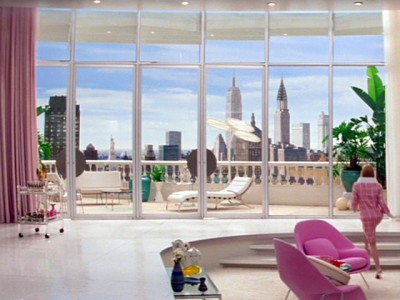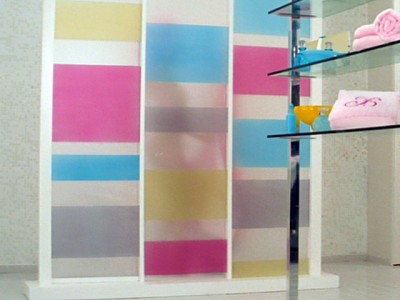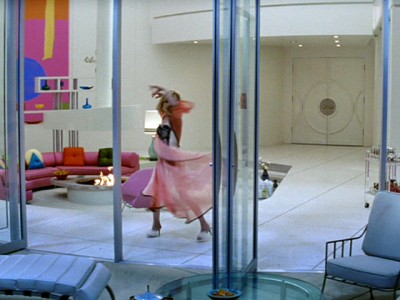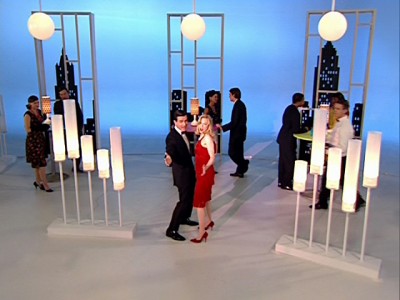
Down With Love, released in 2003, is a homage to classic Doris Day & Rock Hudson films of the 1960s, starring Ewan McGregor and Renee Zellweger. It works as both a tongue-in-cheek commentary and earnest love letter to that style of romantic comedy film.

Critics buried the film, and basically no one but me and my Mother saw it in the theaters. But two crew members did get nominated for a few independent film awards, and rightly so, because they were the meat and potatoes of this venture.
Costume designer Daniel Orlandi totally nailed the spirit of a typical Doris Day wardrobe, which was fabulous! Production designer Andrew Laws studied the sets of the original Day-Hudson films, then injected them with the revival of mid-century modern design that was foaming to a head, and thus created the ultimate fetishistic object for MCM design fans.
Over the years, I have seen Pillow Talk – where Doris Day plays an interior decorator – easily 40 times. The sets are just as important as the actors and the plot and, for the last 10 years or so, I watch the backgrounds more than the foreground. So when Down With Love set decorator Don Diers said their sets were intended to be a “distinct character in the film,” my applause is deafening for a goal perfectly achieved. As with Pillow Talk, I can watch this film with the sound down and still be wildly entertained.
The movie begins with this narration:
The place: New York City
The time: now – 1962. And there’s no time or place like it.
Diers confirmed this by saying, “Our New York exteriors existed in the back lot world of Universal. We made a concerted effort to recreate a 1963 Hollywood New York, as opposed to anything that might have been mistaken for reality. Through Fox Research, we searched a lot of old movie stills for just the right tone.”
This level of fantasy detail is supremely delightful. Bringing to life idealized versions of what 1962 surely looked like is thoroughly satisfying and can be a time-consuming hobby.
Here’s a piece on how to re-create the Barbie doll feel of Barbara Novak’s penthouse apartment.
As much as I genuinely love and strive to document real-world examples of mid-century modern architecture and design, I do get uneasy about the fetish aspect of it. The definitions of “fetish” succinctly explain my uneasy feelings:
1. an object regarded with awe as being the embodiment or habitation of a potent spirit or as having magical potency
2. Any object, idea, etc. eliciting unquestioning reverence, respect or devotion
3. Any object or nongenital part of the body that causes a habitual erotic response or fixation
Finding evidence of a design time period and collecting the items and/or trying to recreate that look is a time-honored tradition. Early American architecture was founded on the revival of most every European building style of most every century. So, reverential recreation of mid-20th century design is a natural progression, and may be the only thing that finally preserves the best examples of such for future generations.
But there does exist unrealistic expectations among those cultivating a mid-century way of living. The most intriguing example comes from the stories of a realtor friend who specializes in finding St. Louis MCM homes for her clients.
In a nutshell, some folks want to live in subdivisions with homes like these, but they want it to look exactly as it did when first built. They look at what 40+ years of inhabitant’s remodeling did to the place and just don’t want to deal with the effort required to restore it to that original state.
Remodeling industry figures show that the average homeowner remodels at least the kitchen and bathroom every 10 years, and that when someone moves into a pre-existing home, some form of remodeling will take place. This is a psychological, aesthetic and functional desire to erase previous footprints and mold the home to your wants and needs.
If the house is over 25 years old, it’s going to automatically need upgrades to systems, roofs and exterior finishes. Maintenance is an on-going chore for a house of any age.
It is easily understood that the purchase of a period home is going to require a lot of work. Whether wanting to totally modernize it or restore it to its original state, it is the equivalent of a second full-time job until the job is done. Wait, the job is never truly done, so scratch that. It’s more like raising a child.
A house built in the 1950s or 60s is now, technically, a period home. Aside from the maintenance and repairs it will require, if you want to take it back to the original form, it requires remodeling. Many homeowners – especially first-time buyers – understandably don’t want to deal with this much work and expense. If that’s their mindset, then walking into a 1960s ranch that only looks like that from the outside is a major bubble pop, and disillusionment thwaps hard upside the head.
But what is it about mid-century architecture that makes it harder for us to accept the remodeling realities of a place that has been normally remuddled over the decades? Why do we expect these period homes to be like a perfectly preserved dollhouse?
Maybe it’s because it is the recent past. The second half of the 20th century went by at lightening speed; 25 years can feel like only 5 years gone, and how much can you mess up something in that short period of time? A home built in 1912 is an antiquated beast requiring massive work to bring it to current standards. But a 1950s ranch has central air conditioning and drywall, so we recognize it as “of our time.”
Then we see something like Down With Love, where they wave a magic Hollywood wand and create a mid-century Xanadu. Target lets us take home credible recreations of that era. Dwell shows regular people living in that world. It’s as easy as populating a dollhouse, right?
If only.

















